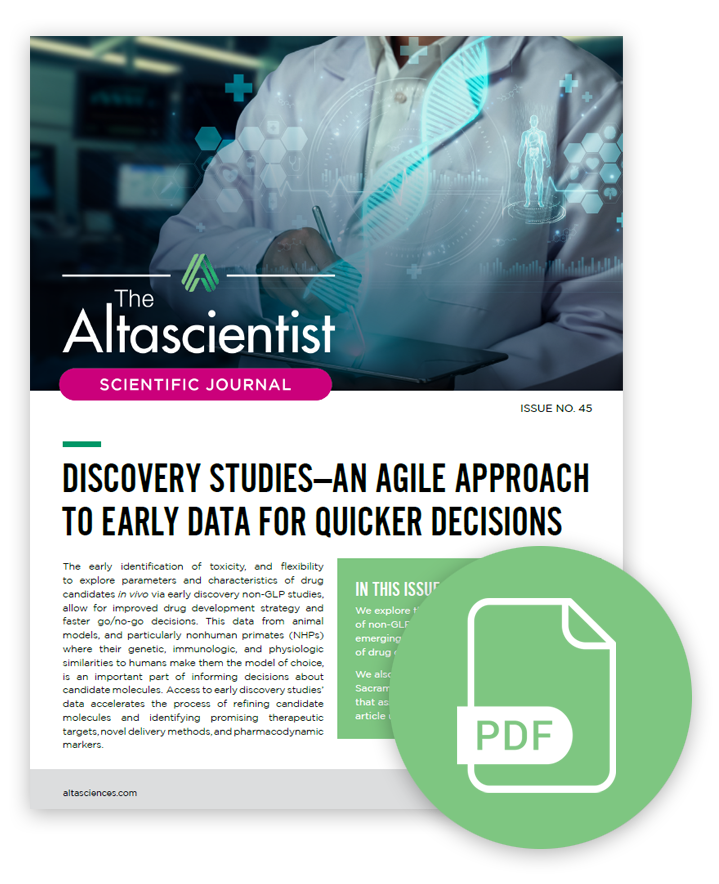ISSUE NO. 45 — Discovery Studies: An Agile Approach to Early Data for Quicker Decisions
The early identification of toxicity, and flexibility to explore parameters and characteristics of drug candidates in vivo via early discovery non-GLP studies, allow for improved drug development strategy and faster go/no-go decisions. This data from animal models, and particularly nonhuman primates (NHPs) where their genetic, immunologic, and physiologic similarities to humans make them the model of choice, is an important part of informing decisions about candidate molecules.
Access to early discovery studies’ data accelerates the process of refining candidate molecules and identifying promising therapeutic targets, novel delivery methods, and pharmacodynamic markers.
In Issue 45 of The Altascientist, we explore:
- the characteristics and advantages of non-GLP discovery studies
- emerging trends in drug delivery methods two early-stage biodistribution case studies
The Value of Conducting Non-GLP Discovery Studies
Early discovery non-GLP studies offer tremendous flexibility in study design, execution, and documentation. As the study advances and based on results, test groups can be added or modified in real time, and dosages or the route of administration changed.
Prior approval of such mid-stream modifications is not necessary, although detailed documentation and record-keeping remain crucial for scientific integrity. For example, a sponsor developing a new medication can test different routes of administration very early in their program and choose the most likely drug candidate to proceed to GLP studies and further development.
Discovery studies are generally fast and cost-effective. These studies do not have to undergo the rigor of regulatory requirements, allowing for faster start-up, shorter testing durations, less detailed and more flexible protocols, smaller sample sizes, and faster report delivery. It is worth noting that the approaches used by Altasciences lead to streamlined processes and lower administrative burden, delivering quick study initiation, execution, and data review. Ultimately, this accelerated approach allows researchers to make go/no-go decisions more rapidly.
How Discovery Studies Support Scientific Exploration of New Delivery Methods and Approaches
In early-stage research, non-GLP studies are excellent options for exploratory study and proof-of-concept investigations of new modalities and drug delivery technologies. Their flexibility allows researchers to focus on scientific discovery and enables rapid experimental adjustments.
Drug delivery methods are constantly evolving, and discovery studies can provide critical data about whether such advancements are applicable to a new molecule being developed. Examples of current trends in drug delivery methods include adeno-associated viruses (AAVs), engineered virus-like particles (VLPs), and lipid nanoparticles (LNPs).
Altasciences’ Decades of Experience in Discovery Studies
With decades of experience and expertise in biomedical and behavioral research, our 31,000-square-foot preclinical facility in Sacramento, CA, specializes in translational research in large molecule NHP studies with expertise in cell and gene therapy, ocular studies, and CNS research, having conducted over 140 studies. We have immediate access to a large colony of acclimated animals ready to go on study, thus expediting your research.
Read Issue 45 to learn more about the characteristics and advantages of non-GLP discovery studies.
Explore all issues of The Altascientist in our Resource Center. And don’t forget to subscribe to “The Altascientist: Audiobooks” on Spotify, Apple Podcasts, or wherever you get your audio content.
